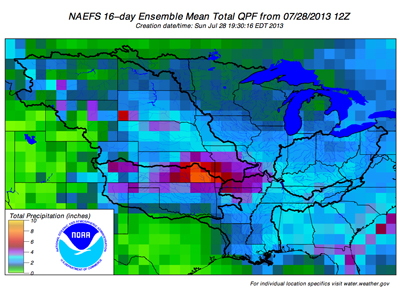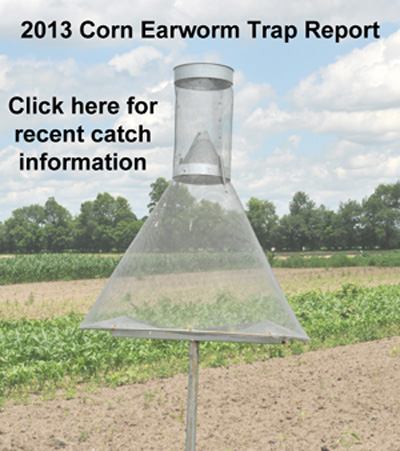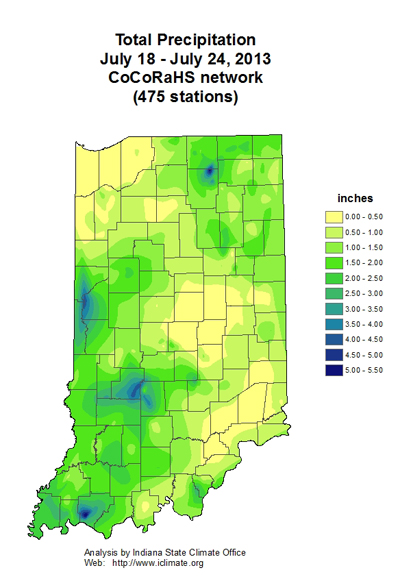USDA-NIFA Extension IPM Grant
Pest & Crop Newsletter, Entomology Extension, Purdue University
Western Bean Cutworm Flight Intensifying – (Christian Krupke and John Obermeyer)
• Moth counts starting to spike this week.
• Egg laying and egg hatch is occurring.
• Scout for egg masses and hatched larvae ASAP in high-risk fields
The western bean cutworm (WBC) trapping season continues, it looks like we are approaching the peak in emergence, with one Newton County trap having over 1,000 moths! Not too surprising that many counts are surging – our recent weather of very high temperatures along with rains helped pupae finish off development and emerge from the soil. Currently, clear nights with light breezes (i.e. no storms) are absolutely perfect for moth flight, mate-finding and egg-laying.
A large percentage of this year’s eggs will be laid over the next 2 weeks. Use this year’s trap catches (see following trap report) and recent history as your guide for prioritizing scouting areas. As you view the “Western Bean Cutworm Adult Pheromone Trap Report”, notice the variability of moth captures, even within close proximity of each other. Although the relationship between trap catches and damage is not particularly strong (i.e., high trap counts does not always mean high damage), traps are a good timing mechanism and presence/absence indicator. When they spike suddenly, it’s time to scout. A larger number should be prioritized for scouting over a smaller one. But that’s about as far as we can take trap counts in assessing damage potential. Areas/fields with damage last year will likely be at most risk this year, but damage will spread to adjacent counties to the south and east of the corn northwestern “hot zone” for WBC.
Many Bt corn hybrids offer excellent control of WBC and will not require scouting for foliar insecticide treatment. However, some Bt hybrids do not offer any protection, as well as specialty corn, e.g., popcorn, high-oil, etc. Scouting is straightforward - a matter of walking fields and looking for egg masses, generally laid on the top surface of the plant’s upper, most upright leaves. Concentrate your efforts on pre-tassel corn, this growth stage is preferred by female moths as the young larvae initially feed on pollen. If more than 5% of plants surveyed have egg masses, treatment is advised. If needed, early insecticide applications are better than late ones – pyrethroid insecticides will offer enough residual activity in most cases for a few days of killing hatching larvae as they travel on their way into the plant’s whorl or leaf axils. Once they get inside the whorl/ear of the plant they cannot be contacted with insecticides, so get them early. Happy Scouting!
Some trappers have been truly dedicated to count their nightly western bean cutworm catch.
![]()
Soybean Aphid Update – (Christian Krupke)
Reports from northern and central Indiana Counties, including our scouting efforts at the Diagnostic Training Center reveal that soybean aphid are present, but in very low numbers. We are finding infestations of just 1-5 aphids on a plant (and most plants have no aphids), usually a female surrounded by offspring. The timing of late July/early August is not unusual, as soybean growth is typically entering the early pod-development growth stages (R3-R4) and this is when soybean aphid infestations have peaked in the past in Indiana. It has been several years since Indiana producers have had to manage this pest, but this may be a year where we break the trend in some fields. The dry and cooler temperatures we are experiencing presently favor soybean aphid reproduction, so soybean fields should be scouted very soon. Happy Scouting!
![]()
![]()
Click here to see the Black Light Trap Catch Report
![]()
Western Bean Cutworm Adult Pheromone Trap Report
![]()
Soybean Vein Necrosis Virus Confirmed in Indiana – (Kiersten Wise, Gail Ruhl, Christian Krupke) -
The Purdue Plant and Pest Diagnostic Lab (PPDL) confirmed Soybean Vein Necrosis Virus (SVNV) this week in Indiana. The virus was first detected in Indiana in 2012, but was not detected until late August. Currently, the virus has only been confirmed in LaPorte County (northwest IN), but it is likely that other fields may be affected. It is important to accurately diagnosis SVNV since it can resemble other diseases and disorders, including herbicide injury.
Symptoms caused by this virus include light green patches or mottled green and brown speckled areas associated with veins (Figure 1). As symptoms progress, affected leaf tissue may die, and leaves will appear scorched.
SVNV is a member of the Tospovirus family, which are vectored by thrips. These are tiny, winged insects that are present in all soybean fields, every year. They feed on plant juices and pollen, but they are not considered pests and have not caused damage to Indiana soybeans in the past. Although growers may be tempted to apply an insecticide to reduce thrips populations “just in case”, at this point in time we do not recommend insecticide applications in response to detection of SVNV, for two reasons: 1) the disease is not yet found widely in the state, and 2) we don’t know what, if any, effect disease may have on yield. For now, we will continue to keep an eye on this disease, and assess its potential impact so that we can make more informed future management recommendations. We encourage growers and consultants to inspect fields for symptoms of SVNV and send samples to the PPDL for diagnosis so we can gather information on the extent of this new disease in Indiana.
Symptoms caused by this virus include light green patches or mottled green and brown speckled areas associated with veins.
![]()
Weather Outlook by NWS OHRFC – (James Noel, NOAA/NWS/Ohio River Forecast Center) –
Fairly good growing conditions will continue across Indiana the into early August.
Temperatures and rainfall will be slightly below normal through August 3.
From August 4-15, more summer-like weather will build in with a return of a tropical air-mass. This will allow temperatures to return to normal or above normal and rainfall to normal or above normal.
The latest 2 week rainfall map is located here: <http://www.erh.noaa.gov/ohrfc/HAS/images/NAEFS16day.pdf>.
Right now, August is shaping up to be about normal from all the latest indications.

![]()
![]()






